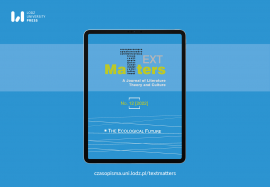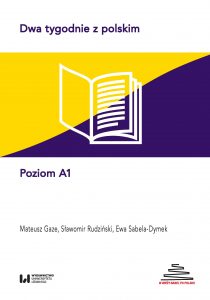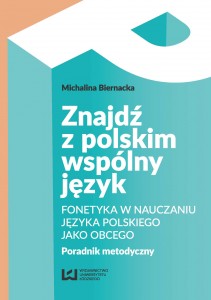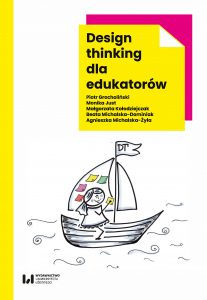Text Matters | No. 12: The Ecological Future (EXTENDED OVERVIEW)
Opublikowano: 15 March 2023

Text Matters: A Journal of Literature, Theory and Culture, based at the University of Lodz, is an international and interdisciplinary journal, which seeks to engage in contemporary debates in the humanities by inviting contributions from literary and cultural studies intersecting with literary theory, gender studies, history, philosophy and religion. Text Matters was founded and developed by Professor Dorota Filipczak (1963-2021).
The journal focuses on textual realities, but contributions related to art, music, film and media studies addressing the text are also invited. Submissions in English should relate to the key issues delineated in calls for articles which will be placed on the website in advance. The journal also features reviews of recently published books, and interviews with writers and scholars whose work has been recognized in the areas addressed in TM. Responses to the articles are more than welcome so as to make the journal a forum of lively academic debate. TM is based in a university in central Poland, but its intercontinental advisory board of internationally renowned scholars makes it possible to connect diverse central perspectives. The style sheet and other useful information can be found on our website.
Inside No. 12: “The Ecological Future”:
Agnieszka Soltysik Monnet; Christian Arnsperger
“Stories of Making and Unmaking”: Deep Time and the Anthropocene in New Nature Writing
Amy Player
New Nature Writing reflects many of the anxieties which are becoming increasingly prevalent in the Anthropocene, an era which necessitates temporal leaps between the present moment, the deep past, and the deep future. Coming to contextualize our impact on the planet in the Anthropocene era in such expansive, geological terms poses profound challenges to the ways we have conventionally framed our wider place on Earth. When viewed through the lens of deep time, our impact on the planet has been comparatively brief, but we are scarcely beginning to comprehend its lasting effects. While the scale of the environmental problems we have created often seems insurmountable, this chapter argues that writing which helps us to think about deep time and acclimatizes us to its vast scale can itself serve as a way for us to grapple with the immensity of the problems we face. Through a consideration of the writing of new nature writers Robert Macfarlane and Kathleen Jamie, it looks at how their engagements with deep time challenge the feelings of helplessness that the scale of the environmental crisis can sometimes burden us with. By arguing that coming to terms with the Anthropocene is to come to terms with a changing narrative we tell ourselves about our role on the planet, it considers how New Nature Writing is playing a crucial role in this narrative shift more specifically, as it explores different ways for us to reimagine our relationship with the more-than-human world in the Anthropocene era.
Comics in the Anthropocene: Graphic Narratives of Apocalypse, Regeneration and Warning
Małgorzata Olsza
Narratives of the Anthropocene function in the realm of not only scientific but also popular discourses. Indeed, the most popular narratives of the Anthropocene, namely the story of the apocalypse and the story of progress, with their respective temporalities, are particularly well-represented in comics. The present article looks at the Anthropocene through the lenses of word and image, tracing the response of the medium of comics to the ongoing catastrophe, including Joe Sacco’s Paying the Land (2020), Scott Snyder and Yanick Paquette’s modern take on Swamp Thing (2019) and Richard McGuire’s Here (2014). Paying the Land is a story of the Dene people and their response to the Anthropocene. Drawing on the opposition between nature and progress, it examines whether empathy can stop capitalistic exploitation of Indigenous communities and the land which they cherish. Swamp Thing, seemingly a narrative of environmental apocalypse, also functions as a story of ecological reconciliation and regeneration. Finally, Here builds on and deconstructs the narrative of progress, demonstrating how a specific location has and will be transformed from 3,000,500,000 BCE to 22,175 CE, offering the reader/viewer a non-chronological look at environmental changes. Apart from the visions of the now and the future that these graphic narratives present, temporality coded in their “grammar” (layout, panels and gutters) is also discussed.
John Michael Greer
Christian Arnsperger, Agnieszka Soltysik Monnet, John Michael Greer
Christian Arnsperger
An awareness of deep time—both humanity’s deep past and the Earth’s deep future—and an understanding of its existential implications can significantly enhance the chances that humanity might still be able to transition towards an ecologically sustainable way of inhabiting the biosphere. This essay explains in detail why this is so, using analysis of a science fiction story that evokes existential horror at humanity’s ultimate cosmic insignificance. With the tools of “terror management theory” (a paradigm of existential thought based on the work of Ernest Becker and emphasizing the saliency of the denial of death in human motivation and behaviour) and of “existential economics” (an approach postulating that the way in which the economic system is organized and operates is crucially influenced by this widespread denial of death), the essay suggests that death denial has turned into the capitalist denial of life, and that only a deep reconciliation of humanity with its true ontological place in the universe will make it possible for us to transition towards a regenerative rather than a destructive system. This will entail new modes of human thinking, feeling, and acting anchored in a shared sense of “joyful insignificance,” as well as a renewed sense of “cosmic indigeneity”—a sense that all humans are indigenous to this planet and that this fact has major implications for how we ought to live into the deep future, anchored in our deep past.
Robustness and Vulnerability: Caring for the Earth in an Age of Loss
William deBuys
Christian Arnsperger, Agnieszka Soltysik Monnet, William deBuys
Firing up the Anthropocene: Conflagration, Representation and Temporality in Modern Australia
Philip Hayward
The European colonization of Australia introduced a new population into a continent in which Indigenous people had practiced cyclic burning as a form of ecosystem maintenance since time immemorial. The settlers’ complete disdain for Indigenous knowledge and related practices caused these customs to largely fall into disuse. One result of this was an increased vulnerability of landscapes to bush fires, a factor that has risen to the fore in the early twenty-first century. The fires that have swept across the landscape with increasing frequency and ferocity have provoked fears of a rolling, fiery apocalypse that might make living in many areas of the continent untenable. This marks a new phase of settler anxiety that has been fuelled by extensive coverage of fires on broadcast and digital media platforms. Blending discussions of Indigenous culture, 19th-21st-century European settler visual art, literature and modern communications media, this article begins by examining the nature of Anthropocene modernity and the very different worldviews and practices of Australian Indigenous peoples. Particular attention is given to senses of time and of living and working with fire. Subsequent sections open up the topic with regard to the planetary present and how we might adjust to the future.
Prophesying the End of Human Time: Eco-Anxiety and Regress in J. G. Ballard’s Short Fiction
Dominika Oramus
Despite being written half a century before the term “eco-anxiety” (Gifford and Gifford) was coined, J. G. Ballard’s disaster fictions can be read in the context of the social psychodynamics of climate change. My aim in this article is to demonstrate that in J. G. Ballard’s fiction, climate catastrophes and the devastation of nature cause the characters to realize that the Earth is not going to be able to sustain human life much longer, and their psychological reaction is either subdued anger or strange numbness. In order to do this, I analyze two short stories by Ballard: “Deep End” (1961) and “Low-Flying Aircraft” (1975) and show how their protagonists are affected by the landscape they inhabit: de-populated wastelands whose wildlife is extinct or mutated. I argue that it is their awareness that human civilization on earth is coming to its end that results in the state of mind akin to eco-anxiety. The characters are immersed in their own inner space and in these stories clocks mark not the passage from past to future but a countdown to the end.
Alicja Relidzyńska
The recent acknowledgement of the Anthropocene, resulting from the increasingly visible human-induced effects on the biosphere, has ultimately obliterated the nature/culture division (Latour; Chakrabarty), prompting sociocultural changes (Autin). Hayley Eichenbaum’s photography series The Mother Road (2015–19) serves as a prominent example of a contemporary American cultural text which reinterprets existing aesthetic strategies and shows symptoms of what I propose to identify as Anthropocene nostalgia. This new sentiment is characterized by the awareness that a return to the past is impossible and would be pernicious, given the detrimental effects of reckless capitalism fuelled by twentieth-century American consumer culture. This article aims to analyze this distinctive type of nostalgia and its juxtaposition with the Anthropocene in Eichenbaum’s series. An analysis of The Mother Road identifies why and how this new sentiment corresponds with the aesthetics of previous decades, as well as notions of temporality and time. Building on previously conceptualized traditions as codes of reference, Eichenbaum reinterprets the representation of Route 66 by playing with its iconography, creating images which evoke desolate, quasi-post-apocalyptic landscapes. With the use of synthetic colours, digital manipulation, kitsch imagery, and mindful deconstruction of past aesthetic strategies, the analyzed series demythologizes the past and displays the loss of both nature itself and of pre-Anthropocene perception.
Environmental Neocolonialism and the Quest for Social Justice in Imbolo Mbue’s How Beautiful We Were
Brygida Gasztold
The article addresses the problems of environmental degradation, as illustrated and explored in Imbolo Mbue’s recent novel How Beautiful We Were (2021), which juxtaposes the fictional oil company Pexton’s corporate greed with the push for rapid economic growth in a less developed world. Intrusions into the fictional African country’s sovereignty are manifested by foreign capital’s extraction of its most valuable natural resource—oil—which results in environmental harm and the disruption of Indigenous, communal life. The novel critiques the hazardous methods of crude oil exploitation, which put human health and life at risk. It demonstrates how uneven distribution of oil’s benefits sanctions corruption and fosters economic injustice, while all attempts at restoring justice are thwarted as much by local as by foreign culprits. The novel’s defense of traditional ways and the critique of Western modernity and capitalism encourage the search for grounds on which alternate epistemologies could be built. At the intersection of Western dominance and Indigenous response, the novel explores how local groups mobilize the visions of the past to oppose extractive projects. As the novel’s nostalgic title signals the happy times now bygone, its multigenerational interest brings modernity into focus. Finally, I argue that the novel’s memories of colonial extractive practices not only highlight the importance of resource temporalities around resource extraction but also emphasize their impact on the future of local communities.
Emily Childers, Hannah Menendez
Contemporary climate fiction (cli-fi) frequently invokes the concept of apocalypse to explore the experience of living through the era of unprecedented climate change and environmental disaster that has been named the Anthropocene. Yet, as often as apocalyptic narratives are deployed to express those anxieties and experiences, they so often ignore the histories and presents of peoples who have already lived through multiple apocalypses—in particular, the ongoing violence of settler colonial exploitation of the land now called North America. Considering the role that settler colonialism has played in the development of the current crisis, we turn to two recent works by the Métis writer Cherie Dimaline and Ojibwe author Louise Erdrich to consider how the act of cultural storytelling challenges Western notions of linear temporalities. Our analysis of Dimaline’s The Marrow Thieves will explore how the settler-colonial narratives of scientific progress is challenged through Indigenous storytelling and collective memory, and our analysis of Erdrich’s Future Home of the Living God will examine how Indigenous modes of understanding operate through a cyclical timescape that allows for alternative methods of existing with and within the larger world.
Erika De Vivo
The 2018 edition of the Sámi festival Márkomeannu elaborated a narrative about the future of both the environment and society by articulating fears of an oncoming apocalypse and hopes for Indigenous Sámi futures through a concept presented to festivalgoers via site-specific scenography, visual narratives, and performances. This essay, addressing the festival as a site of artistic activism, reveals the conceptual bases and cultural significance of the festival-plot in relation to Indigenous Sámi cosmologies, the past and the possible future(s) in our time marked by escalating climate change. I argue that Márkomeannu-2018, providing a narrative about the future in which, amidst the Western societies’ dystopic colonial implosion, Indigenous people thrive, can be regarded as an expression of Indigenous Futurism. Counterpointing 19th-century theories predicting the imminent vanishing of Indigenous peoples while positioning the Sámi as modern Indigenous peoples with both a past and a future, this narrative constitutes an act of empowerment. Sámi history and intangible cultural heritage constituted repositories of meaning whereas a folktale constituted a framework for the festival-plot while providing an allegorical tool to read the present.
Monika Kocot
It seems that in order to overcome the current ecological crisis we need a new (global?) narrative. If the narrative of “progress” that has functioned as one of the Western cultural myths is linked to the notions of modernity and Enlightenment, then perhaps we need a new vision of modernity and “enlightenment.” This change might become part of a paradigm shift associated with a new view of ecology and the natural world, as proposed by Thich Nhat Hanh, the father of engaged Buddhism in the West. This paper aims to show how Gary Snyder and Kenneth White, two like-minded world-renowned poets and environmental activists, contribute to a new cultural paradigm: transmodernity. The non-dualism and Eastern philosophy that White and Snyder find valuable represent a rejection of Western modernity, and its cult of progress and telos. The emphasis will be placed on the importance of the Hua-Yen Buddhist philosophy, centred upon the metaphor of “Indra’s net,” and the ways in which it informs Snyder’s and White’s writing and Earth-centred activism. Snyder’s Buddhist anarchism is nowadays, more than ever before, intertwined with deep ecology. White’s radical geopoetics is becoming more and more popular, showing that the paradigm is shifting. As I will argue, the impact of “Indra’s net” on the dynamics of this gradual process is undeniable.
Matthew Harrison Tedford
Inspired by what literary scholar Lisa Lowe calls “the past conditional temporality”—or the “what could have been”—this paper examines how the work of 20th-century Cuban American performance artist Ana Mendieta challenges modernist ontologies that separate the human from the non-human, simultaneously calling on older ways of being and demonstrating that they never disappeared. Many argue that the ecological crises of the Anthropocene are in large part due to the proliferation of modernist worldviews that set humans apart from the non-human world. The rise of European rationalist philosophies in the early modern period played a central role in the proliferation of instrumentalist relationships between humans and the non-human world.
This paper explores how Mendieta’s Silueta and Rupestrian Sculptures series (from the 1970s and 1980s) resist the logic of European capitalism and colonialism, revealing that the relationships that rationalism sought to subdue have always existed, will continue to exist, and can proliferate. Symbolic communication is a key means of mediating and actualizing relationships between subjects, and so, if a non-instrumental relationship is possible between the human and non-human, visual art ought to be a possible means of enactment. Through Mendieta’s work, this paper considers the mechanisms by which this is possible. By considering meaning-making as a basis for life, the co-constitution of human/non-human subjectivities, and the inherent permeability of the category of the individual, this paper highlights counter-modernist visual art practices that are of special urgency in the age of the Anthropocene.
Katarzyna Ostalska
In Richard Powers’s Pulitzer Prize-winning The Overstory (2018) the theme of the novel is the forest ecosystem, with a special emphasis placed on trees, upon whose developmental model the processes of (organic and industrial) growth are scrutinized in this novel. This article examines tree-human assemblages in detail to see how they exchange their material agency and how they relate to the e/Enlightenment project. The essay also explores Powers’s novel to examine how Buddhist values of spiritual enlightenment are contextualized within European Enlightenment and how decentred humanity finds its place among other non-human beings. Apart from fictitious characters from The Overstory, the article draws upon the research of real-life scientists who inspired the creation of Powers’s protagonists: Prof. Simard and Dr. Beresford-Kroeger, along with the work of anthropologist Anna Tsing. In addition, eco-solutions concerning the tree ecosystem (i.e. bio-planning and the seed banks) coming from the scientific field and the field of literature (Powers) are examined to see if today’s progressive ideas can function in the world of the—still, to a large extent, “regressive”—structures of modernity’s legacy. I conclude by arguing that the novel shows that the Enlightenment project is not compatible with the well-being and long-term survival of both humans and non-human beings.
Courtney A. Druzak
This article examines M. R. Carey’s 2014 zombie apocalypse novel The Girl with All the Gifts through the ecofeminist concept of trans-corporeality as defined by Stacy Alaimo in Bodily Natures. Carey’s heroine Melanie showcases how humans can re-conceptualize their relationship to a more-than-human, or natural, world that is both exterior to the self and always-already a part of the self through fungal agency. Indeed, the novel continuously engages in intimate human-environment interconnections that, in their horrific capacities, are meant to inspire readers to reflect upon their own enmeshment in a larger, material world. The novel’s use of the real fungus Ophiocordyceps as the more-than-human agent that inspires the transformation of humans into zombies provides a vision for how humans can more ethically relate, in posthuman manners, to a more-than-human world. Finally, this article considers the novel as a depiction of slow horror, or a gradual descent into apocalypse.
Ecotopia. Based on Ernest Callenbach’s Ecotopia. Adapted by Elizabeth Watson
Elizabeth Watson
Agnieszka Soltysik Monnet, Christian Arnsperger, Elizabeth Watson
Appositions: The Future in Solarpunk and Post-Apocalyptic Fiction
Katarzyna Więckowska
The essay discusses images of the future in solarpunk and post-apocalyptic fiction, focusing on their distinct approach to the narratives of progress, science, and individualism. The dystopian perspective of post-apocalyptic fiction is juxtaposed with the hopeful stance of solarpunk stories in order to outline the attempts to move beyond environmental pessimism and to imagine a liveable future. A reading of Cormac McCarthy’s The Road (2006), Erik M. Conway and Naomi Oreskes’s The Collapse of Western Civilization (2014), and Omar El Akkad’s American War (2017) provides an overview of early 21st-century dystopian motifs and visions, while the ideas and development of solarpunk fiction are discussed on the basis of three anthologies of short stories: Sunvault: Stories of Solarpunk and Ecospeculation (2017), Glass and Gardens: Solarpunk Summers (2018), and Multispecies Cities: Solarpunk Urban Futures (2021). The aim of the essay is to argue that apocalyptic and solarpunk fiction stand in a relationship of apposition to one another, representing dominant and emergent structures of feeling.
Edyta Lorek-Jezińska
The recent exhibition of Patricia Piccinini’s art called That’s Us (Toruń, CSW) largely represents the Australian artist’s visions and fascinations known from earlier exhibitions. Questioning and erasing the borders between species, the affective realities of Piccinini’s art are bound to the concepts of care, empathy and fragility, which refigure what is human and non-human and the relations between them by expanding the notion of mothering and fostering to include interspecies relations. Beginning with a discussion of the uncanny, abjection and monstrosity, this article aims to examine the complicated implications of interpreting Piccinini’s art within the conceptual framework of ecofeminism, as well as in the context of disability aesthetics. In her explorations of different and alternative corporealities, Piccinini, among many other things, asks questions about ideologies of normativity and able-bodiedness, suggesting the possibility of going beyond them.
Sympoiesis, Autopoiesis and Immunity: How to Coexist with Nonhuman Others?
Audronė Žukauskaitė
In this essay I will discuss Donna J. Haraway’s notion of sympoiesis and examine different modes of cohabitation or hybridization with nonhuman others. Such concepts as sympoiesis, or holobiont, question the notion of the biological individual and also change our understanding of what it means to be human. As Richard Grusin pointed out, “we have never been human” because “the human has always coevolved, coexisted, or collaborated with the nonhuman—and that the human is characterized precisely by this indistinction from the nonhuman” (ix–x). We have never been human because we have always been dependent on other species living within or beyond our bodies. However, the question which still needs to be answered is whether all forms of coexistence are profitable and welcomed. How does one define the limit at which this co-existence is collaborative and productive (“posthuman”), and beyond which it becomes damaging and lethal (in other words, “posthumous,” e.g., coming after life)? For this reason, the interrelations between different life forms should be discussed together with the concepts of contagion and immunity. The notion of immunity expresses an ambivalent character of life: on the one hand, it protects the organism against everything that is beyond its boundary; on the other hand, it helps to collaborate with other organisms and to create an ecosystem. In this sense, immunity can be thought as a field of negotiations between human and nonhuman beings.
Echoes of Rituals of Initiation and Blood Sacrifice in Heart of Darkness by Joseph Conrad
Andrzej Wicher
In Heart of Darkness, the protagonist Kurtz, of whom we do not, in fact, see much, is shown as connected with a native “sorcerer,” a “witch-man,” who had “antelope horns” on his head. Antelopes, or goats, are typical sacrificial animals, and the protagonist of this novella is a European who perishes in the midst of tropical forests, in spite of the high hopes that accompany his decision to try his luck in an exotic environment. Kurtz has promising beginnings, but later he gradually degenerates, carrying out what may be called a reversal of the ritual of initiation, comparable to the inverted ritual, to use V. Propp’s term, in folklore. In this sense, he may be regarded as a counterpoint to Conrad himself whose life can easily be described as a modern and uncommonly successful enactment of the same ritual. Meanwhile, Kurtz’s, and to a lesser extent also Marlow’s, failure as initiates is inscribed in the failure of the European civilization to construct a European empire in Africa.
Narrating Wonder in Mark Anthony Jarman’s Stories
Jason Blake
Mark Anthony Jarman’s characters are often down and out, and often wandering and wondering. Using theories of wonder, this essay argues that wonder plays a key role in many of Jarman’s stories—stories that are marked not by narrative or psychological closure, but by a sense of wonder as characters muse on their lot in life. After briefly considering Jarman’s role within Canadian literature, including his innovative approaches to the short story form, and his odd status as an influential yet often ignored writer, the essay moves to a discussion of the various ways that wonder is at play in his works, both as a verb and a state. Jarman’s characters are frequently in doubt, and the act of wondering takes us into their drifting, self-reflecting minds. However, there is also the sense of wonder as the miraculous. Jarman’s narrators find optimism in the world around them, thanks to flashes of the beauty of the unlikely. Wonder, thus, has a crucial structural function.
The Butterfly Effect: Creating and Recreating the Story of Madame Butterfly, on Paper and on Stage
Magdalena Szuster
The consequences of the partially coerced opening of Japan to the Western world in the second half of the 19th century went far beyond economic and political goals and considerations. The previously secluded land almost instantly became a source of artistic inspiration and endless fascination. Japonisme, the term by which the latest craze become known in France, was no passing fad. For many decades, Western artists, most of whom had never set foot in Japan, derived profound inspiration from all facets of the mysterious culture which unfolded in the period. Thus, with scant information and a lack of accurate records being available, common gossip and unfounded rumor filled in the blanks of official reports and naval tales, connecting the dots between the real and the imagined.
In this paper, I succinctly examine the story of Madame Butterfly, cutting across time, genre and borders in the works of John Luther Long, David Belasco, Giacomo Puccini and Claude-Michel Schönberg/Alain Boublil. I contextualize the selected narratives within their socio-political frameworks, but also consider the ramifications of the past and present-day adaptations from the 21st-century perspective, in the light of current struggles for (adequate) representation. Lastly, I examine the production of Miss Saigon (2019–22) at the Music Theatre of Łódź, Poland to compare how the staging of such a musical in a predominantly racially homogenous country affects the perception of Orientalist works. As such this section is a case study based on personal interviews conducted by the author with the producers and cast members.
Museum Project: 14 Henrietta St. Museum, Paula Meehan, Dragana Jurišić and the Irish Housing Crisis
Joanna Kruczkowska
The aim of the article is to compare three (re)creative activities within one interdisciplinary project: a public space (14 Henrietta St. Museum in Dublin), poetry (Paula Meehan’s cycle of sonnets in Museum of 2019) and photography (Dragana Jurišić’s photos in the same book). They are all examined in the light of the current housing crisis in Ireland, which followed the collapse of the Celtic Tiger in 2008. The Museum project not only comments on the crisis and the changing social relations in Ireland but also challenges the perception of history and private/public memory. In the article, the components of the project are situated against biographical and historical backgrounds, and within the framework of new museology, memory studies, and the functions of photography and poetry.
Monet at a Glance: A Dynamic, Ekphrastic Encounter in Michèle Roberts’s “On the Beach at Trouville”
Marta Goszczyńska
The essay analyzes Michèle Roberts’s 2012 story “On the Beach at Trouville” as an ekphrasis of Claude Monet’s early Impressionist painting, The Beach at Trouville. It first approaches the narrative though W. J. T. Mitchell’s model in which ekphrasis is understood as staging “a war of signs,” only to conclude that the dynamics between the painting and the story is too complex to be satisfactorily explained in these terms. As a result, the essay moves on to read the story as an “ekphrastic encounter” and uses Norman Bryson’s concept of the glance to account for what happens between Roberts’s text and Monet’s image. Bryson discusses the glance in opposition to the totalizing, immobile and disembodied gaze and understands it both as a way of looking and painting. The essay reveals how the glance can be used to explain important dimensions of Roberts’s ekphrastic project: its depiction of Monet’s picture as a semiotic system of arbitrary signs, its emphasis on the durational, performative aspect of painting, its insistence on the contingent nature of interpretation, and, finally, its attempts to mimic Monet’s Impressionist style. All these features, the essay argues, allow Roberts to transform her story into a dynamic scene of intermedial dialogue where word and image enter a relation of what Stephen Scobie describes as “reciprocal supplementarity.”
Nec Tecum Nec Sine Te: The Inseparability of Word and Image in Virginia Woolf
Małgorzata Hołda
This article explores the interaction of verbal and visual art in Virginia Woolf’s fiction, exemplified by her novel, To the Lighthouse. The narrative of the novel not only features scenes of the painting of the Ramsays’ portrait, but it unfolds as the creative process advances and concludes with Lily’s final stroke of her brush. While words are used to enact the process of creation, visual art serves as both a frame and a basis for the verbal. The synergistic movement of storytelling and the act of painting a picture “within the narrative” is more than an interesting instance of ekphrasis. In To the Lighthouse, words operate like pictures—according to Horace’s maxim, ut pictura poesis—and pictures work like words. Art’s resonance in the novel extends beyond depicting the process of painting. I examine Woolf’s aesthetic sensitivity and creative talent in relation to Paul Cézanne’s and Paul Klee’s art. The proximity between Woolf’s novel and the works of the two painters encourages us to view the role of shape and color in the two seemingly separate arts as the space for uncovering some vital truth about our being-in-the-word.
Magdalena Cieślak
“Productivity of Constraint”: Wit Pietrzak in Conversation with Philip Terry
Wit Pietrzak, Philip Terry
Komentarze
Ten post dostępny jest także w języku: Polish





